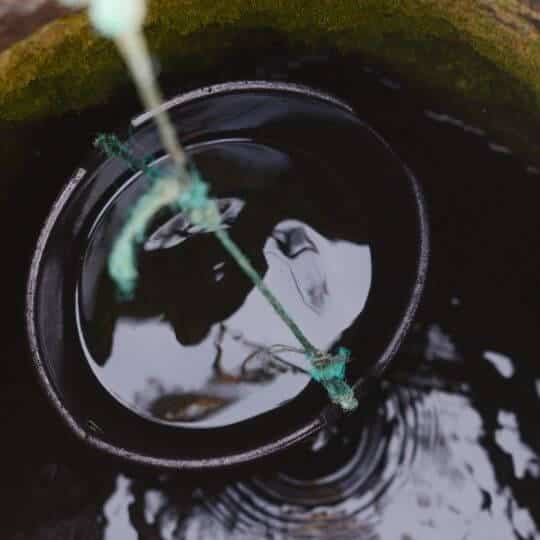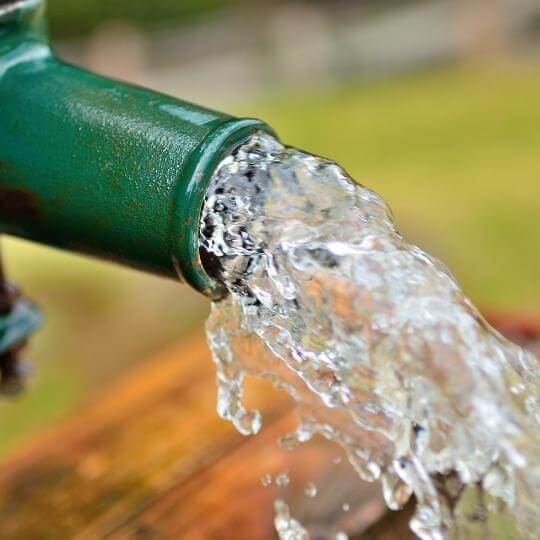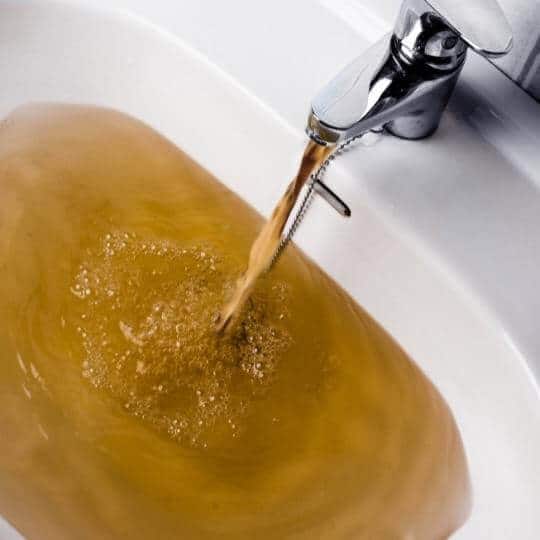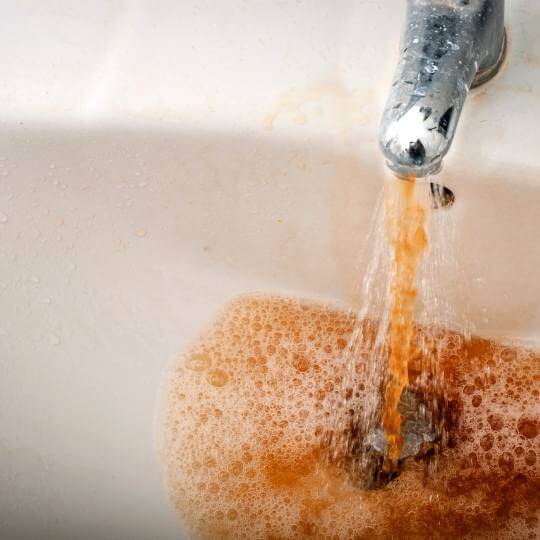Have you ever noticed that your well water is brown? Few things are more concerning than turning on your faucet and noticing water has a strange color.
Even if brown well water is not necessarily hazardous, its quality is low and you want to change that.
In this post we will be looking at what causes brown well water and the problems associated with it. In the end, we will offer some simple and effective solutions to treat brown well water.
Why Well Water is Brown or Reddish?

Brown well water can be described using various terms: red, orange, and rusty. Rusty is the one color that also describes the most common cause of this phenomenon – and that is rust.
What happens is that old pipes made of cast or galvanized iron leak rust into your water supply. The more intense the brown color, the higher the concentration of rust.
But oxidized pipes are not the only source of rust in your well water. Well water can naturally contain high levels of iron, resulting in a brownish color.
Another common cause of brown color in well water is represented by tannins.
Tannins are naturally occurring organic material originating from decaying leaves. They can seep through the ground when it’s raining and enter water streams. This is why homeowners usually notice brown water after heavy rains.
You can recognize tannins by the yellowish stains they leave on clothes and fixture. At the same time, you will notice and earthy smell and tangy aftertaste in water. In small amounts, tannins are not dangerous, but just make the water unpleasant to drink.
How to determine exactly what causes brown well water

Is it rust or is it tannins? Or maybe another mineral?
If you are not sure why well water turns brown after sitting, you can test your water.
This is very easy to do with a simple water test kit purchased online. These affordable tests have 100 strips for testing 16 parameters. Other benefits include:
- Being able to complete tests without being a professional
- Determining contamination with lead, mercury, fluoride, bacteria, copper, iron, zinc, sulfate, total chlorine, nitrite, nitrate, hardness, manganese, and others
- A portion of the sales being donated to partner brand Water for Good. This is a nonprofit charity tackling water poverty in the Central African Republic.
Is brown well water safe for drinking?

When you use drinking water from your well you may notice that well water turned brown overnight. This can happen after heavy rainfall.
But is it safe to drink well water that has a brown color?
If the water is contaminated with manganese or iron, it is safe to drink. Even if it looks, smell, and tastes bad, it will not harm you. Iron and manganese are actually good for your body. They are part of those natural elements that help your body function properly.
On the other hand, when you notice well water turned brown overnight, this could suggest contamination. Brown well water could contain more than iron and could be contaminated with bacteria. These can be harmful for your health.
So, if your cold well water is brown, best is to test it and find out the cause of the discoloration. Most water test kits can detect bacterial contamination and let you know if well water is safe for drinking.
If you have no other option that to drink brown well water, boil it before consumption. The brown color will persist, but at least you will have killed the potential bacteria.
What other colors can well water have and what do they tell?

Well water can become discolored for a variety of reasons and have the most unusual colors. [1]
- Black
Black indicates magnesium in your water supply. This element interacts with oxygen and other minerals, causing a black color of water.
- Green or blue water
Green and blue indicate corrosion of copper and bronze plumbing. Drinking this water is dangerous for your health.
- Milky white water
Cloudy water can be a result of air trapped in your water supply, which means the problem is temporary. Put some water in a glass and observe it for a few minutes. If water clears from the bottom up, it means that air bubbles were the culprit.
Why you should avoid using brown well water?
Brown well water could be safe or not for drinking. One thing is for sure – it will stain everything that comes in contact with it.
Brown well water will cause stains on your clothes, sinks, bathtub, toilet, fixtures, etc. If you use it for watering your lawn, it will also stain the grass. The iron particles will be transferred to your shoes as you walk in your yard. Your house’s walls and your fences will have stains as well if water coming from your sprinklers is rusty.
Other issues associated with water rich in iron include:
- Clouding and sediment
- Metallic taste and smell
- Altered appearance of food
- Pipe buildup
- Dry and itchy skin
- Bacterial overgrowth
Many people want to find out how to get rid of brown well water in order to avoid the problems described above. In the last section we will talk about some solutions for treating your well water.
How to get rid of brown well water?
Depending on what’s causing brown well water, there is a number of fixes for this problem:
- Ion exchange water softener
These house water softeners are installed at the water’s point of entry before the water heater. Ion exchange softeners reduce water hardness but also attracts iron to their positively-charged media bed. This means they can also eliminate rust from water.
- Greensand filters
These filters are coated with manganese oxide, which oxidizes iron and manganese and turns them into solids. Impurities are caught on the surface of the media bed until they are backwashed.
- Air injection oxidization
Air injection filters introduce oxygen into a pressure tank, oxidizing ion and manganese. The oxidized particles stick to the surface of a media bed, which regularly cleans itself from impurities.
- Reverse osmosis
This is one of the most effective filtering treatments as it can remove almost 100% of organic material from contaminated water. Best is to install these filters before water enters the house, but they can be placed under the sink, too.
Water undergoes several stages of filtration through a reverse osmosis membrane. This eliminates almost all contaminants, including bacteria, lead, sulfur, and iron.
- Sediment filtration
Your well water would be pure had it not been contaminated with sediments? In this case you can opt for a sediment filtration system, which has pores between 1 and 5 microns in size. The most common solids such as dirt, dust, sand, and rust are retained by this type of filter.
- Replacing rusty pipes
A very simple and effective fix is eliminating the cause of the problem. When your water is colored by rust coming from your pipes, best is to change those pipes. The disadvantage is the complexity of this project. In many cases, you will need to call to a plumber’s services.
Even if pipe replacement can cause lots of disruptions, best is to do it. In the end, those rusty pipes will start to leak and even burst, causing more problems and water damage to your home.
The Takeaway
Why is my well water suddenly rusty, you may ask yourself.
A brown color of your well water may not be a sign of a serious problem. However, we recommend you to be prepared for the worst-case scenario and take the following steps:
- Test your water to find out what causes the brown color of your water;
- Determine if your well water is safe for drinking;
- Install a filter;
- Replace pipes if rust inside them causes the brown color of your well water.
Even if the water is not contaminated with dangerous substances, it will stain everything it touches. We guess you may want to avoid that.

Michael Davis is a heating & plumbing expert who currently works as independent contractor in SC. He also writes for Plumbertip.
For almost 10 years he worked on various plumbing tasks across South Carolina.



